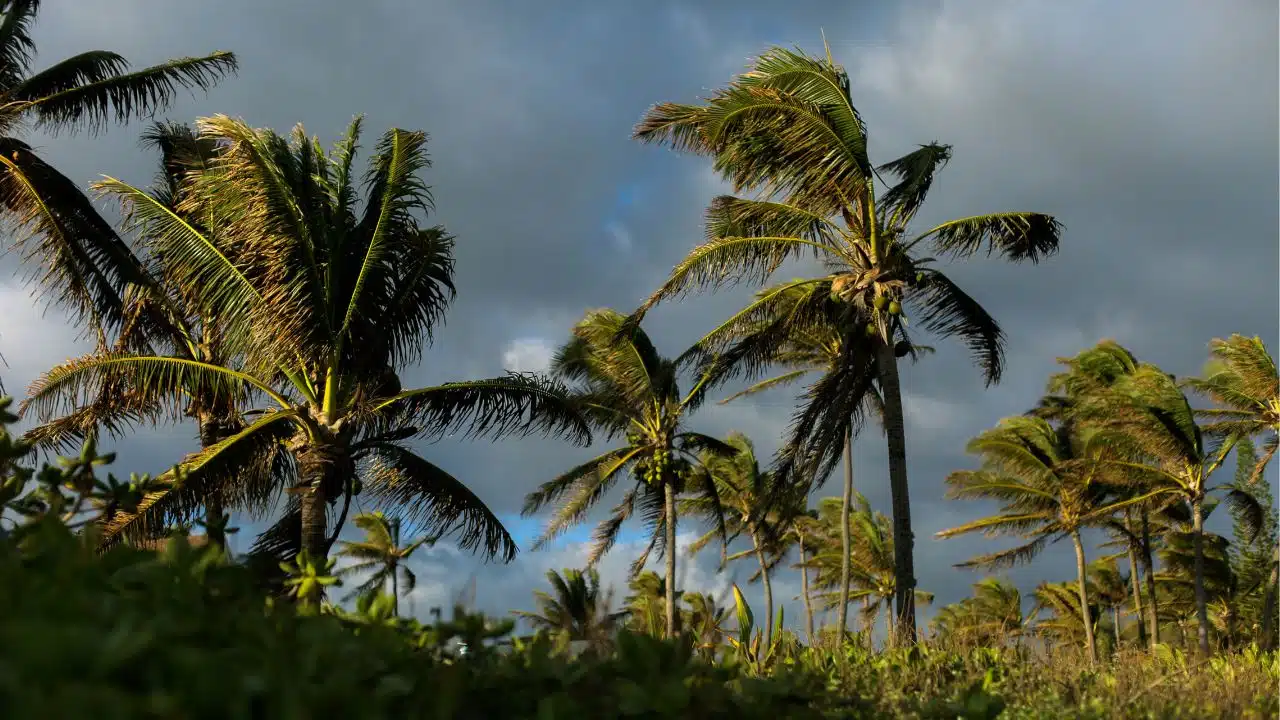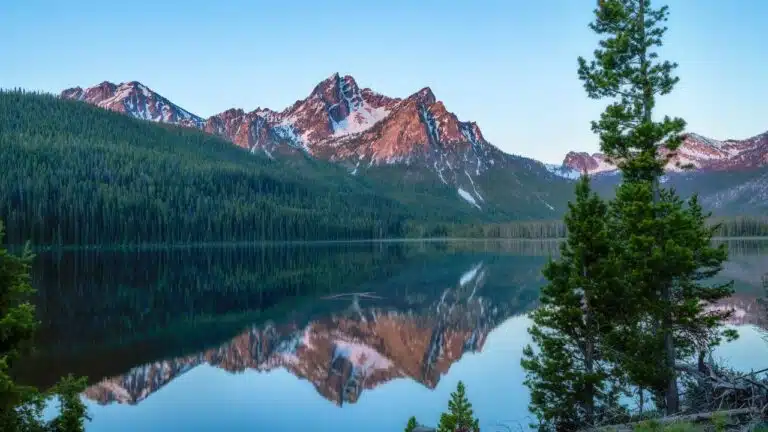The Aloha State is full of welcoming delights, from soaring mountains to adventurous jungles and sweeping coasts. But one not-so-welcoming aspect of the Hawaiian Islands is the hurricanes. Unfortunately, hurricanes are a fact of life for many island getaways, and Hawaii is no exception. Consequently, if you’re visiting Hawaii, you’ll need to prepare. So, here’s your quick and handy guide on what to expect and how to stay safe during hurricane season in Hawaii.
Table of Contents
- FAQs about Hawaii’s Hurricane Season
- 7 Tips for Hurricane Preparedness
- Next Vacay Can Help You Fly Any Time
FAQs about Hawaii’s Hurricane Season
Planning a sunny summer getaway to the tropics? The last thing you might expect to have to do is consult with the National Hurricane Center. But, when one of the most popular times to go to Hawaii just so happens to coincide with the islands’ hurricane season, it pays to be prepared. So, here’s what you need to know about tropical storms in Hawaii and visiting the islands during hurricane season.
Do Hurricanes Ever Hit Hawaii
Hurricanes do hit Hawaii, but not often. According to the National Oceanic and Atmospheric Administration, the central Pacific region experiences four to five tropical storms yearly. However, since recordings began in 1950, only a handful of those tropical storms have caused the Hawaiian Islands severe damage, and only two ever made landfall.
Hurricane Nina (1957) was the first hurricane on record near the islands. While it never made landfall, it set an all-time record for wind gusts, 82 mph, in Honolulu. Two years later, in 1959, Hurricane Dot made landfall in Kauai, causing extensive damage to the island’s crops. Almost a decade later, Hurricane Estelle (1986) passed south of Hawaii, producing high surf, flooding, and minor damages.
The most recent hurricanes to hit Hawaii were by far the worst. Hurricane Iwa (1982) passed within 25 miles of Kauai and brought surging waves, heavy rain, and winds of over 120 mph. But, without a doubt, the strongest storm to hit Hawaii was the only other one to make landfall. Hurricane Iniki (1992) struck in the heart of hurricane season in September, killing six people, sweeping away homes, and causing over three billion dollars in damages.
How Often Is Hawaii Hit by Hurricanes?
Thanks to a geographical miracle, hurricanes don’t often plague Hawaii. In fact, only two have ever made landfall in the past 72 years. Hawaii hurricanes are rare, even during hurricane season, for three important reasons: size, favorable winds, and ocean temperature.
While the islands are certainly bigger than you think, they might as well be invisible to hurricanes when hidden within the sprawling Pacific Ocean. However, even when tropical cyclones do manage to come close, Hawaii has a natural defense system of easterly winds and warm ocean waters.
Essentially, whenever a tropical storm gets close, easterly trade winds surrounding the Hawaiian Islands blow it westward. This happened with Hurricane Lane during Hawaii’s 2018 hurricane season, with easterly winds preventing landfall on the islands.
And if the winds don’t take care of the hurricane? Well, leave it to the ocean. Tropical cyclones need warm ocean waters, typically above 80 degrees, to gain momentum. But, when they start churning up the ocean water near Hawaii, they dredge up the cold water found on the ocean floor and disperse.
With this trifecta of just the right factors, Hawaii manages to dodge the worst of the tropical storm season, even in the middle of hurricane season!
When Is Hurricane Season in Hawaii?
The infamous hurricane season in Hawaii stretches from June 1st to November 30th, but July through September presents the highest risk of tropical storms. Case in point, the last major hurricane to hit Hawaii, Iniki, made landfall in September. However, a tropical storm can pop up at any time. So it’s best to stay prepared.
What Is the Best Month to Go to Hawaii?
While summer is a popular time to visit Hawaii, it’s not the only option. Thanks to amazing year-round weather, Hawaii is outstanding in every season, but the best month to go is May. Just outside the hurricane season, May offers some of the best rates and weather to explore the islands.
Traveling in May allows you to avoid the hurricane season in Hawaii. While tropical storms can happen throughout the year, they’re much less likely in May, which offers some pretty favorable weather conditions, like little rain and sunny, blue skies. In addition, May is considered Hawaii’s off-season, so it’s the perfect choice for a more affordable vacation. You can dodge the peak crowds and price hikes that accompany the summer and winter months, which are some of the most popular times to visit the Hawaiian Islands.
Is There a Tsunami Season in Hawaii?
Unlike hurricanes and much like other natural disasters, tsunamis don’t stick to a particular season. Because they’re mainlyy caused by earthquakes, they can occur at any time throughout the year. The last major tsunami to hit the Hawaiian Islands was the Tohoku tsunami in 2011.
The Tohoku tsunami, like many others, was caused by an earthquake, one originating in Japan. However, although Hawaii experiences thousands of earthquakes every year, the likes of the 2011 tsunami are predicted to be a once-in-a-thousand-years event.
Despite the rarity of such an event happening again anytime soon, Hawaii officials have implemented tsunami evacuation maps and other safety measures to help mitigate future damages and loss of life.
7 Tips for Hurricane Preparedness
As the saying goes, you can hope for the best so long as you’re prepared for the worst. Even if hurricanes are rare in Hawaii, planning what to do if one creeps up will help you keep your trip planning (mostly) worry-free. So, check out these seven top tips for preparing for hurricane season in Hawaii.
1. Sign Up for Emergency Alerts
Whether it’s hurricane season in Hawaii or just a random day in March, the best way to stay prepared is to stay informed. Monitoring the local news is a great start, but if you want to ensure you never miss an alert, sign up for emergency notifications. Getting alerts is free no matter which island you visit. Best of all, they can keep you informed of everything on the Hawaiian Islands, from high surf to flash flooding and incoming tropical cyclones.
Depending on where you’ll be, you can choose the local emergency notification systems to join for your next visit.
2. Check In with Your Hotel
Hawaii does have some hurricane evacuation shelters to protect against strong winds and intense rains, but these are often used as a last resort. As a result, you may end up sheltering in place at your hotel. Check in with the hotel staff about their evacuation procedures and how they plan to communicate the latest updates so that you can stay informed. The Red Cross can also help you find open shelters when natural disasters loom.
3. Contact Your Airline
Mother Nature waits for no man; at no time is that more apparent than when she brings your flight to a screeching halt. If you get caught in Hawaii in the middle of a hurricane watch or warning, your flight could possibly be delayed or canceled. So, before you pack up and head to the airport, call your airline to see what’s happening with your flight and when you can reschedule if needed.
If you’re heading to Hawaii in the middle of hurricane season, consider buying travel insurance for added peace of mind. With coverage for delays, interruptions, or cancellations, you can breathe a little easier anytime a storm warning crops up for the central Pacific.
4. Have Cash on Hand
We may live in the digital age, but having cash on hand can go a long way during natural disasters. From downed ATMs to no electricity for credit card machines, you may not be able to access your money digitally. So keep some cash, especially smaller bills, in an emergency kit, along with some backup chargers for any electronics.
5. Charge Your Electronics
Speaking of backup power sources, remember to charge your electronics. Amidst the panic of an oncoming storm, it’s easy to forget little details like your phone battery, so don’t forget to plug in.
6. Stay Out of the Water
Even at the best of times, the ocean is not to be underestimated. So, heed those warnings when a storm rolls around during hurricane season in Hawaii—or outside of it, for that matter. Although you may see some brave souls taking to the epic swells brought on by nearby storms, staying out of the water before, during, and after a storm is always a good idea. Even if the waters look calm, they can grow murky from stream and river runoff caused by heavy downpours and hide unknown dangers.
7. Update Your Friends and Family
Keep everyone up-to-date, whether you’re traveling with friends and family or they’re waiting for you back home. Choose group meetup spots in advance in case of separation, and always let others in your group know where you are or will be so someone has an idea of your whereabouts.
Next Vacay Can Help You Fly Any Time
Hurricane season, shark season, or the wet season, it’s always a great time to visit Hawaii. But with pesky price hikes everywhere, from summer holidays to winter getaways, it’s not always a great time for your wallet. Luckily, Next Vacay can take a bit of the sting out of booking your next flight. With a team of deal hunters finding only the best prices and savings, you can escape to paradise without the usual price tag.
Before you know it, even your wallet will be saying Aloha to the Hawaiian Islands. Hawaii awaits … fly with Next Vacay!



